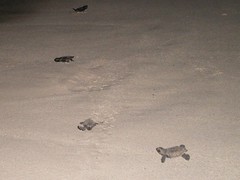 We moved temporarily to Barbados on September 1 last year. The apartment is nearly right on the beach. We feel very fortunate. It took me awhile to realize that not only do we have access to one of the most beautiful beaches on the island with swimming in Caribbean blue water but we have turtles.
We moved temporarily to Barbados on September 1 last year. The apartment is nearly right on the beach. We feel very fortunate. It took me awhile to realize that not only do we have access to one of the most beautiful beaches on the island with swimming in Caribbean blue water but we have turtles.In the first month we would snorkel and see what looked like discarded ping pong balls strewn across the reef that is our backyard. We'd pick them up underwater, bring them to fresh air and realize that these were not athletic equipment but some sort of egg. Then we went on a turtle patrol walk along the south coast of the island. We saw hundreds of baby turtles and one turtle track. Still, I did not think of our beach as a turtle nesting beach. Plus, I knew what a marine turtle track looked like because we became fascinated with Leatherback turtles in Trinidad a few years prior. It was not until November when turtle hatchlings came scurrying up from the sand on our beach that I understood the magic that we have on this beach. They've been here nearly the whole time. Certainly we see sea turtles when we are snorkeling but they've been nesting and hatching throughout most of our time here.
 Yesterday when I went for a morning run I saw eleven turtle tracks along my usual route. That was more than usual. Today I saw just two, but the point is there are tracks and nests every morning. Here are two from a couple of weeks ago.
Yesterday when I went for a morning run I saw eleven turtle tracks along my usual route. That was more than usual. Today I saw just two, but the point is there are tracks and nests every morning. Here are two from a couple of weeks ago.When you come to Barbados, wake up early and take a walk along the beach and you will see the tracks. Most beaches enjoy frequent visits from nesting turtles, I'd say from May to October. It's best not to walk up to a nesting turtle, shine a flash light (or torch) on her, or scare her in anyway. If you see hatchlings, feel lucky! But let them make the journey to the sea on their own; don't help them, they need to feel the sand and stretch their legs because they have their work cut out for them.
 These turtle shots are from my Flickr account.
These turtle shots are from my Flickr account.
1 comment:
And if you have control over your abode, reduce your outdoor lighting as much as possible! The turtle hatchlings use the "bright" night sky to orient themselves towards the "dark" sea, and if it's overshadowed by artificial lighting inland they travel the wrong way!
Post a Comment